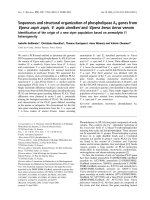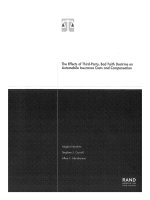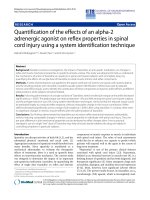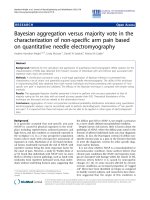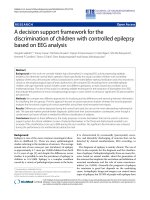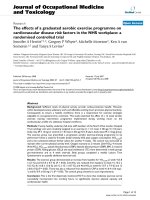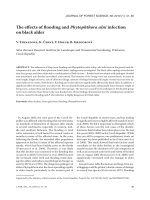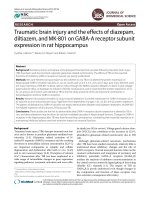THE EFFECTS OF TEACHER’S DIFFERENTIATED INSTRUCTIONS BASED ON STUDENTS’ LEARNING STYLES ON THEIR MOTIVATION
Bạn đang xem bản rút gọn của tài liệu. Xem và tải ngay bản đầy đủ của tài liệu tại đây (357.09 KB, 16 trang )
CHAPTER 1: INTRODUCTION
1. Statement of the problem
The researcher has recently identified some questionable problems in her
reading class: 1) the students were not motivated enough to actively join in class
activities; 2) some students were somehow more involved in certain activities while
sometimes the others even showed no interest in these ones at all. Different activities
may evoke different reactions and feelings from different students. Moreover, because
learning style is an influential factor on motivation, teacher’s accommodation to
students’ different learning mode appears to probably raise the level of motivation.
For the aforementioned reasons, the researcher decided to start an action research
project named “The effects of teacher’s differentiated instructions based on students’
learning styles on their motivation.”
2. Aims, objectives and research questions of the research
This study is supposed to examine the relationship among three concepts
learning styles, differentiated instructions and academic motivation in higher
education classroom setting. In the light of that general aim, some specific objectives
are drawn up to outline the actual directions of the study as follows:
1) To identify the given class’s learning styles and current level of academic
motivation;
2) To project and implement some instructional differentiations upon the students’
different learning modalities aiming to improve their academic motivation;
3) To evaluate the impact of the psycho-pedagogical intervention on the students’
motivation level.
b. Research questions
1) What are the students’ learning styles and their current level of motivation?
(Identifying the problem)
1
2) To what extent does the new intervention cater for the students’ learning styles?
3) How does differentiated instruction approach affect the students’ motivation
level in terms of their motivational intensity, lecturer evaluation and English
learning desire?
CHAPTER 2: LITERATURE REVIEW
1. Key Concepts
1.1. Learning styles
a. Definition of learning styles
Among these countless trees, there is one oak which should not and cannot be
ignored. The definition by Keefe (1979) has been mentioned in lots of learning style
research (Reid, 1987; Willing, 1988; Coffield, 2004). “Learning styles are
characteristic cognitive, affective, and physiological behaviors that serve as relatively
stable indicators of how learners perceive, interact with, and respond to the learning
environment … learning style is a consistent way of functioning, that reflects the
underlying causes of learning behaviors.” (p. 40)
b. Learning style theories, models and measures
Dunn and Dunn’s VAK/ VAKT models
2
Dominant
learning styles
V: Visual A: Auditory K: Kinesthetic T: Tactile
Joy Reid’s VAKT model
Reid’s VAKT was basically similar to that of Dunn and Dunn with more than
two styles. These two, group and individual were also very important in student’s
process of gaining and retaining knowledge. Hence, from the researcher’s viewpoint,
Reid’s model was more complete to some extent. As a result, in the scope of this
research, Reid’s model will be used thoroughly.
1.2. Differentiated instruction (Teaching style/ teaching approach)
Differentiating instruction means teachers’ “adjusting the curriculum and
presentation of information to learners rather than expecting students to modify
themselves for the curriculum” (Hall, Strangman & Meyer, 2003)
To differentiate instruction is to recognize students' varying background knowledge,
readiness, language, preferences in learning and interests; and to react responsively.
Differentiated instruction is a process to teaching and learning for students of differing
abilities in the same class. The intent of differentiating instruction is to maximize each
student's growth and individual success by meeting each student where he or she is and
assisting in the learning process.
(Hall, Strangman & Meyer, 2003)
1.3. Motivation
a. Definition of motivation
In this study, the definition by Wlodwoski (1985, p. 2, quoted by Root, 1999)
will be used thoroughly. Motivation is regarded as “the processes that can (a) arouse
and instigate behavior, (b) give direction or purpose to behavior, (c) continue to allow
behavior to persist, and (d) lead to choosing or preferring a particular behavior.”
b. Motivation model - Components of motivation
Based on Gardner’s construct and these studies, Dörnyei has integrated all the
components into one construct with three components specifically as follows:
3
Figure 5: Components of foreign language learning motivation
(Dörnyei, 1994, p. 280)
2. Related studies
2.1. Evidence of effectiveness of differentiated instruction as a classroom
practice
When reviewing the studies about differentiating instructions, Hall, Strangman
and Meyer (2003) noticed that there was not much existent empirical research to
4
prove the theory validity. As a result, the gap in the literature of this area can be
acknowledged and further studies in future should be necessarily encouraged.
Despite the shortage of empirical research, a significant quantity of
testimonials and classroom examples were provided by the authors of several
publications and web sites. Tomlinson (2000) reports the promising results
(improvements in classrooms) of the application of the full model of differentiation in
some educational settings. Initially, this instruction process was introduced to gifted
learners who did have much difficulty in acquiring the content.
The main drawback of this approach is teachers’ unfamiliarity with this
concept when they all can picture exactly how a “single-size instruction class” is due
to their experience over many years. It means the difficulty which teachers must
encounter when it comes to imagine what a differentiated instruction class look and
feel like (Tomlinson, 2001).
2.2. Differentiated instruction and learning style
The link between differentiated instruction and learning style can be recognized
easily. The latter is possibly considered as the motivational cause for the former.
According to learning style theory, no learners are alike. In other words, they are of
different abilities, interest, learning needs and learning styles (characteristic cognitive,
affective, and physiological behaviors). Differentiating instruction which has been
employed for gifted and talented students for the last two decades is definitely not
new. Now it is used widely as an effective teaching tool to address students’ different
learning style and thereby engaging them to make learning progress.
2.3. Differentiated instruction and ESL/ EFL motivation (In the world and
in Vietnam)
Differentiating instructions in classroom provides a wide range of activities,
which helps every student “find learning a better fit much of the time” (Tomlinson,
2001), thereby increasing their motivation to attend class.
5
Tulbure (2011) who did research to investigate the correlation among three key
terms learning styles, differentiation and intrinsic motivation found out that
differentiating instructions according to pupils’/students’ learning styles contributes to
the improvement of the level of intrinsic academic motivation and achievement.
CHAPTER 3: METHODOLOGY
1. Participants
The class which was investigated and took the intervention consists of 26
second-year students. They had just finished their first year at university and were
going to start the second year when this study was undertaken. Their ages range from
19 to 21 years old (with the vast majority born in the early 1990s). The female
numbers which account for roughly 89% of the total outweigh the number of males.
The class students come from different hometown: 23% from cities or the suburbs,
57.7% from countryside, 11.5% from coastal area in the Central and 7.7% from
mountainous area. Although the same curriculum by the Ministry of Education and
Training applied in every primary, secondary and high school in Vietnam, students
from different areas will receive different education due to the conditions of facilities
and the quality of teaching staff in each region (not mention students’ intrinsic
difference).
2. Research instruments
a. Learning style inventory
The researcher decided to adapt Perceptual Learning-Style Preference
Questionnaire (PLSPQ) developed by Reid (1984) as the measuring instrument of
students’ learning styles, particularly for learners of foreign language.
The survey was validated by the split-half method. Originally, one subset of the
learning styles consisted of 10 statements which then were reduced into 5 each after a
correlation analysis. The “user-friendly” PLSPQ consisted of 30 randomly-ordered
6
statements which should be responded on the 5-point Likert scale ranging “strong
disagree to strongly agree”. Some questions were repeated to increase the internal
consistency of the questionnaire after being paraphrased a bit. The PLSPQ
questionnaire also included its scoring sheet which guided the user how to elicit the
respondent’s learning styles via 30 questions.
b. Motivation questionnaire (adapted from Gardner’s AMTB)
The questionnaire consists of 30 items which can be divided into 3 categories
(ten item each): motivational intensity, English writing teacher evaluation and desire
to learn English. Among 10 items of each scale, there are positively keyed and
negatively keyed ones. However, all of these items are presented randomly in the
survey without the three category names (see Figure 10). Each item can be responded
on a 6-point scale Likert (omitted the middle scale in a seven-point scale: undecided
or neutral for a “forced choice” survey).
Scale
Questionnaire item no.
Positively keyed Negatively keyed
Motivational Intensity 1, 5, 8, 13, 14 20, 22, 25, 26, 30
English reading teacher
evaluation
2, 4, 6, 9, 11 16, 17, 19, 23, 28
Desire to learn English 3, 7, 10, 12, 15 18, 21, 24, 27, 29
Figure 10: AMTB questionnaire keys
c. Interviews with the students
Semi-structured interview is selected for this study because of its flexibility and
its possibility of efficient data elicitation (Dowsett, 1986, quoted in To and Nguyen,
2009). Some guiding questions are prepared in advance to guide both the interviewer
and the interviewees to keep on right track of the study purpose and avoid wasting
time with off-track questions. All the questions are in the form of open-ended ones so
as to draw out the most information from the interviewees. The interviews with
students are undertaken to gather the data about the students’ motivation. Two
interviews were conducted after the first and second time of delivering the AMTB
7
after the intervention. Three students were selected, based on the marks and the most
significant change in their marks between the first and the second AMTB.
d. Classroom self-observation checklist or teacher-researcher’s reflection
Because this was an action research, the teacher-researcher self-observed
herself in class. This brought both advantages and disadvantages. Observations in
other kinds of research sometimes may come across some obstacles such as teacher’s
objection to observation, teacher’s unreal simulation or students’ discontent. Self-
observation could happen quite naturally, flexibly and smoothly. However, taking two
roles at the same time could occasionally distract her from either of the task (usually
the observation task) because of total concentration on the other. As a result, self-
reflection form was needed for the teacher to fill in right after the lesson so that she
could remember exactly to every detail which took place in class time.
3. Procedure of data collection
/
8
Phase 1: PLSPQ and
AMTB questionnaire +
interview with some
students
Self-
observation
Interview with
the students
Phase 2: Intervention
(differentiated instructions
by learning styles)
/
/
/
Figure 11: The research first cycle
4. Procedure of data analysis
The AMTB motivation questionnaire will be collected and analyzed according
to the scoring sheet (see Appendix 4). Each items of the AMTB survey has a
numerical value ranging from 1 to 6. Positively keyed items have ascending value
from “strongly disagree” (1 point) to “strong agree” (6) while negatively keyed ones
have descending value from “strongly disagree” (6) to “strongly agree” (1). The
maximum mark a respondent can gain is 180 when he/she chooses all strongly agrees
for positively keyed items and all strongly disagrees for negatively keyed ones. One
the other hand, the minimum mark is 30, which means choosing all 1-point-value
alternatives. The mark can be interpreted as: the more points a person gets in this
survey, the more motivated he/she is. The interviews with the students, classroom
observation and student’s diaries will be coded, transcribed, analyzed and quoted as
the evidence in the study. All the collected data cooperated to help the researcher gain
a thorough overview on the problems and seek out the best solutions.
CHAPTER 4: RESULTS AND DISCUSSION
1. Research questions 1: the students’ learning styles and their motivation level
before the intervention
1.1. Learning styles
The students’ learning preferences and their performance in each learning style
are displayed in Figure 12
9
Self-
reflection
Figure 12. Students’ Perceptual Learning Style Preferences
To sum up, the students in the class did have different preferences when
learning. Tactile, kinesthetic and auditory were the learning styles most of them
found comfortable and good to learn in, visual learning style was the minor learning
modality of the majority of the class whereas these students expressed their strongest
negative preference for working individually.
1.2. Motivation level before the intervention
10
Figure 13: The participants’ level of motivation before the intervention
In short, the students’ intrinsic motivation level is quite high, but it seems to be
badly influenced by the “uninteresting” and “inappropriate” teaching methodology.
Therefore, the motivational intensity is also decreased moderately.
2. Research question 2: the teacher’s differentiated instructions cater for the
students’ learning styles
2.1. Description of new intervention (differentiated instructions)
Differentiation must provide a balance of learning for all students to expose
their unique learning styles so that they could have the best chance to gain necessary
skills, knowledge and thereby achieving success (Anderson, 2007, cited in Fenner,
Mansour & Sydor, 2010).
The intervention called differentiation project was conducted over a six-week
period from September 2012 to October 2012. In light of the research objectives, a set
of stages had been planned:
• Differentiate class activities to cater the students’ learning styles to raise
motivation
11
• Evaluate the students’ motivation each month to keep track of their
progress
Procedure of the intervention
Teacher’s self-observation and reflection helped record what happened in the
classroom. The intervention was a week-by-week action project which lasted for six
weeks. According to the syllabus, the 3A course started at the beginning of September
and lasted for fifteen weeks. The researcher project tried to cover half of the semester
(before mid-term test). Week 1 and week 2 in the syllabus were pre-process stages in
which problem was identified with the first surveys and interview with the students.
The intervention was adapted starting from week 3 to week 8 of the syllabus.
2.2. The extent of the accommodation to learning styles by differentiated
instruction strategies
The first thing was the integration of different skills into one reading lesson.
Secondly, a wide range of assignments was used to offer the students of different
levels and ability good opportunities to learn contribute and expose their strength
(drawing, presenting, critical thinking, etc.).
About grouping, working individually, in pairs, small groups and the whole class
were used alternatively and flexibly in the class to avoid the monotony and vary the
chance every student could work in the environment they feel the most comfortable.
In addition, the roles of the teacher were changed from a powerful instructor into “a
conductor of the orchestra”. The teacher sometimes provided the students with
necessary knowledge or simply told them what to search for and let them do it
themselves. By giving as much responsibility as possible to her students, the teacher
had more time to observe the class and support the low-performing students.
3. Research question 3: the progress of the students’ motivation level during the
intervention
The results of three times of delivering the AMTB were presented together as
follows:
12
Figure 14: Motivational intensity over a six-week period (Sept to Oct 2012)
The first line graph indicates the change in motivational intensity of the students
involved in the research from September to October 2012. The most notable trend
belonged to the highest grade group 41-60 points. Meanwhile, the number of those
who got less than 20 points declined considerably from nearly 27% in September to
only 7.8% in October. Unlike these two vibrant groups, the other mark group (21-40
points) remained quite stable with a slight fall in October. Overall, over the
investigated period the intensity of motivation among the students appeared to grow
significantly.
13
Figure 15: English teacher evaluation over a six-week period (Sept to Oct 2012)
The above line graph reveals another component of the students’ motivation:
teacher evaluation during the same two-month period of the research project. It is
quite easy to recognize both upward and downward trend from this graph. Like
motivational intensity, the lowest grade group (10-20 points) tended to drop rapidly
during the intervention. Likewise, the percentage of the students in middle group
showed a moderate fall in September before rising slowly in to end at 46.1% in the
last week of October. The highest group increased quite sharply by October, but then
reduced its growing speed in the second half of the period. In short, the students seem
to evaluate the teacher in a more positive way.
14
Figure 16: Desire to learning English over a six-week period (Sept to Oct 2012)
The last component named English learning desire was shown in the third line
graph above. The most noticeable thing is no students seemed to long to study
English; therefore, all the students gained more than 20 points in this section. The
highest grade group experienced a gradual increase in the first month and has
remained constant since then. The reverse pattern was true for the last group.
CHAPTER 5: CONCLUSIONS
The results of the study showed that:
15
First of all, learning style was investigated to be the foundation to which the
teacher could tailor suitable teaching method. The most fundamental finding of this
research was to figure out the major (tactile, kinesthetic and auditory), minor (visual)
and negative learning styles (working individually). Therefore, the chosen
intervention was differentiation which suggests a various methods (both matching and
mismatching along with others) to cater for a large number of students instead of
some.
The second finding of this study shows that differentiated instructions of the
teacher had tailored class activities to fit all kinds of learning styles. A particular
learning style has chance to learn in their best condition, but simultaneously step out
of their comfort zone to approach other learning styles to learn more flexibly and
increase their adaptability.
The last finding, also the most important one of the study was the increasing
level of the students’ motivation. The motivation was raised significantly in terms of
motivational intensity, teacher evaluation, and learning desire.
Some conclusions could be drawn from the major findings as follows:
- Students are not alike in their learning, so their LS should be identified and
understood thoroughly.
- Teachers' instructions should be tailored and differentiated in accordance with
students' learning styles for motivation.
- Different methods should be employed to both accommodate students' learning
styles and encourage them to step out of the comfort zones
16
